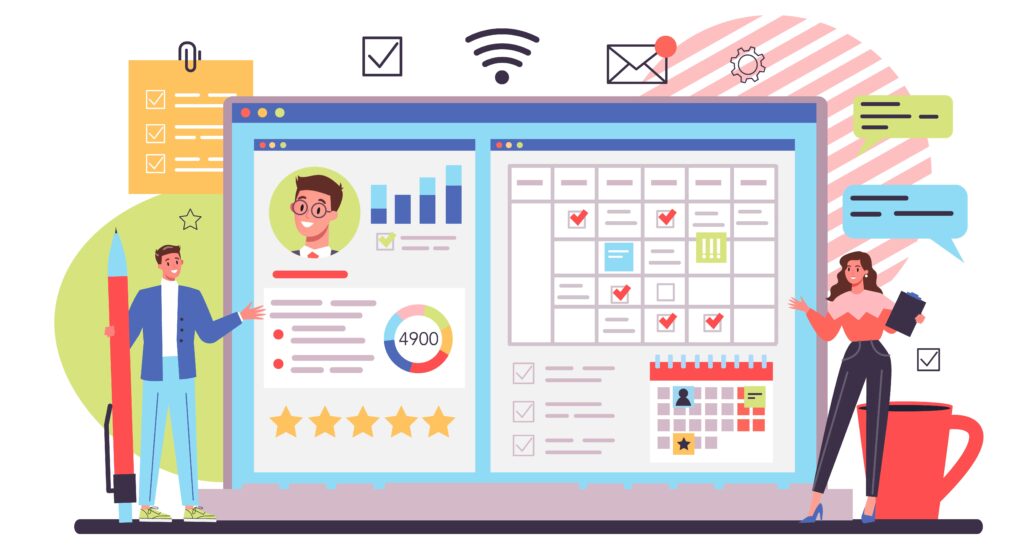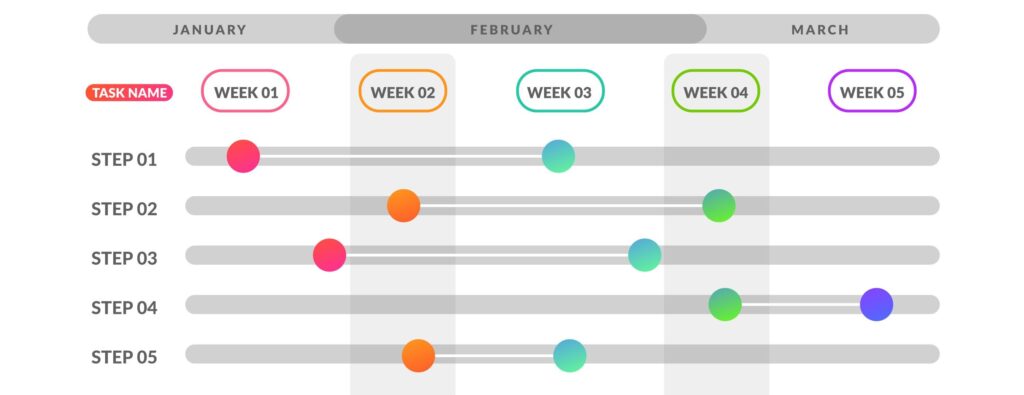The efficiency of a team can make or break a company’s success. As we move into 2024, the importance of streamlined and effective Employee Management Systems (EMS) cannot be overstated. These systems are designed to simplify and enhance various aspects of human resource management, from tracking attendance and performance to facilitating communication and collaboration within teams.
The rise of remote and hybrid work models, accelerated by the global pandemic, has transformed the traditional workplace. According to a study by Gartner, 48% of employees will likely work remotely at least part of the time post-pandemic, compared to 30% before the pandemic. This shift has heightened the need for robust EMS that can adapt to changing work environments and ensure seamless team management irrespective of location.
Moreover, the modern workforce is increasingly diverse and dispersed, requiring tools that can cater to different needs and preferences. EMS are crucial in providing real-time data and analytics, enabling managers to make informed decisions, boost productivity, and foster a positive work culture. In this blog, we will explore the top seven EMS for 2024 that are designed to maximize team efficiency.
Whether you’re a start-up or a large enterprise, these systems offer a range of features to meet your unique needs. From enhancing communication to providing comprehensive analytics, these EMS are set to revolutionize the way teams operate and achieve their goals.

Criteria for Evaluating EMS
Selecting the right Employee Management System (EMS) is crucial for maximizing team efficiency and achieving organizational goals. With numerous options available, it’s essential to understand the key features and attributes that define a top-notch EMS. Here are the primary criteria to consider:
1. Integration
A good EMS must seamlessly integrate with existing tools and platforms within your organization. This includes HR management systems, communication tools, project management software, and other enterprise applications. Effective integration ensures a unified workflow, reducing data silos and enhancing overall operational efficiency. For example, integrating an EMS with Slack or Microsoft Teams can streamline communication, while linking it with project management tools like Asana or Trello can provide a cohesive view of project progress and team performance.
2. Scalability
As your organization grows, so do your management needs. An effective EMS should be scalable to accommodate an increasing number of employees and evolving organizational requirements. Scalability ensures that the system can handle additional users, data, and functionalities without compromising performance. This is particularly important for fast-growing startups and enterprises undergoing digital transformation. For instance, an EMS that scales efficiently can support a small team of 10 today and expand to manage a global workforce of 10,000 tomorrow, all while maintaining optimal performance.
3. User-Friendliness
An EMS should be intuitive and easy to use, minimizing the learning curve for employees and managers alike. User-friendliness encompasses a clean interface, straightforward navigation, and accessible features. A system that is easy to adopt can significantly enhance user engagement and productivity. Employees are more likely to use an EMS consistently if it is user-friendly, leading to better data accuracy and more efficient team management.
4. Analytical Capabilities
A report by Deloitte indicates that companies leveraging advanced analytics can improve decision-making speed by 30% and accuracy by 20%.
One of the most powerful aspects of modern EMS is their ability to provide deep insights through advanced analytics. Analytical capabilities enable managers to track key performance indicators (KPIs), monitor employee engagement, and identify trends that can inform strategic decisions. For instance, predictive analytics can help forecast staffing needs, identify potential issues before they escalate, and tailor professional development programs to individual employees.
In addition to these core features, other important factors include customization options, security, compliance with relevant regulations, and customer support. Customization ensures that the EMS can be tailored to meet specific business processes and industry requirements. Robust security measures and compliance with regulations in order to protect sensitive employee data. Reliable customer support ensures that any issues can be swiftly addressed, minimizing downtime and disruption.
Top 7 EMS for 2024
1. Monday.com
Monday.com is a versatile work operating system that enables teams to run projects and workflows with confidence. It offers a highly visual and intuitive interface, making it easy to manage tasks, projects, and team collaboration.
Key Features:
- Customizable Workflows: Users can customize workflows to fit their unique project needs, making it adaptable to various industries and project types.
- Integrations: Seamlessly integrates with popular tools like Slack, Google Drive, Microsoft Teams, and more, enhancing its functionality.
- Visual Project Tracking: Offers multiple views such as Kanban, Gantt, and calendar views to visualize project timelines and progress.
- Automations: Helps automate repetitive tasks to save time and reduce errors.
2. Asana
Asana is a leading project management tool designed to help teams organize, track, and manage their work. It’s known for its user-friendly interface and robust task management capabilities.
Key Features:
- Task Management: Allows for detailed task creation, assignment, and tracking, with the ability to set due dates, priorities, and dependencies.
- Project Views: Offers various views including list, board, timeline, and calendar to suit different project management styles.
- Collaboration: Facilitates team collaboration through comments, attachments, and @mentions, keeping communication centralized.
- Integration: Integrates with over 100 apps, including Slack, Outlook, and Google Drive, to streamline workflows.
3. Trello
Trello is a popular project management tool known for its simplicity and flexibility. It uses a card and board system that is highly visual and easy to understand.
Key Features:
- Kanban Boards: Trello’s primary feature, allowing users to create boards, lists, and cards to organize tasks.
- Power-Ups: Enhances functionality with Power-Ups like calendar view, integrations with tools like Slack, and custom fields.
- Collaboration: Supports real-time collaboration with comments, attachments, and activity logs.
- Automation: Butler automation allows users to automate workflows and reduce manual tasks.
4. Wrike
Overview: Wrike is a powerful project management and collaboration platform designed for teams of all sizes. It offers robust features for task management, project planning, and team collaboration.
Key Features:
- Customizable Dashboards: Allows users to create custom dashboards to track project metrics and performance.
- Advanced Reporting: Provides detailed reports and analytics to monitor project progress and team productivity.
- Time Tracking: Built-in time tracking helps teams manage their workload and stay on schedule.
- Integration: Integrates with tools like Salesforce, Slack, and Adobe Creative Cloud for enhanced functionality.
5. Smartsheet
Overview: Smartsheet is a work management and automation platform that combines the familiarity of a spreadsheet with robust project management features.
Key Features:
- Grid, Gantt, and Card Views: Offers multiple views to suit different project management needs.
- Automations: Automates repetitive tasks and workflows to increase efficiency.
- Collaboration: Enables team collaboration with comments, attachments, and reminders.
- Integration: Integrates with numerous apps including Microsoft Office 365, Google Workspace, and Slack.

6. ClickUp
Overview: ClickUp is an all-in-one project management platform that offers extensive customization and a wide range of features to suit various team needs.
Key Features:
- Task Management: Detailed task management with subtasks, checklists, and priorities.
- Multiple Views: Includes list, board, calendar, and Gantt views to visualize work.
- Customization: Highly customizable with custom fields, statuses, and workflows.
- Integrations: Integrates with popular tools like Slack, Google Drive, and Zapier for enhanced productivity.
7. Zoho Projects
Overview: Zoho Projects is a comprehensive project management tool that offers a range of features to help teams plan, track, and collaborate on projects effectively.
Key Features:
- Task Automation: Automates task assignments and notifications to streamline workflows.
- Gantt Charts: Provides Gantt charts to visualize project timelines and dependencies.
- Time Tracking: Built-in time tracking for monitoring project hours and employee productivity.
- Collaboration: Enhances collaboration with forums, chat, and document sharing.
How EMS Improves Team Efficiency
Employee Management Systems (EMS) are pivotal in enhancing team efficiency by streamlining various aspects of project management and team collaboration. Here are some key ways EMS can boost team efficiency:
- Centralized Task Management: EMS platforms like Asana and Trello allow teams to centralize task management, ensuring everyone knows their responsibilities and deadlines. This reduces confusion and keeps projects on track.
- Enhanced Communication: Tools like Monday.com and ClickUp integrate with communication platforms such as Slack and Microsoft Teams, facilitating seamless communication. This integration helps in quick information exchange and real-time collaboration.
- Automated Workflows: Many EMS offer automation features that handle repetitive tasks, like sending reminders or updating task statuses. This frees up time for team members to focus on more critical activities, enhancing productivity.
- Comprehensive Analytics: Systems such as Wrike and Smartsheet provide detailed analytics and reporting features, helping managers track progress, identify bottlenecks, and make data-driven decisions. This proactive approach ensures issues are addressed before they escalate, maintaining project momentum.
- Flexibility and Scalability: EMS like Zoho Projects and Smartsheet offer flexible and scalable solutions that grow with the organization. They can adapt to increasing workloads and expanding teams, ensuring consistent performance and efficiency.
Future Trends in EMS
The future of EMS is set to be shaped by several emerging trends that promise to further enhance team efficiency and collaboration. Integration of AI and machine learning will enable EMS to provide predictive analytics, automate more complex tasks, and offer personalized recommendations, making project management smarter and more efficient. As remote and hybrid work models become the norm, EMS platforms will continue to improve features that support remote collaboration, such as virtual whiteboards, enhanced video conferencing integrations, and real-time document editing.
With an increasing number of employees working on the go, EMS platforms will prioritize mobile-first designs, ensuring that all functionalities are easily accessible from smartphones and tablets. Future EMS will incorporate features that monitor and support employee well-being, such as tracking workload balance and providing tools for mental health support. This holistic approach aims to maintain a healthy and productive workforce. EMS platforms will implement more robust security protocols and compliance measures to protect sensitive employee and project data.